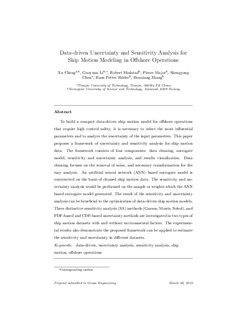| dc.contributor.author | Cheng, Xu | |
| dc.contributor.author | Li, Guoyuan | |
| dc.contributor.author | Skulstad, Robert | |
| dc.contributor.author | Major, Pierre Yann | |
| dc.contributor.author | Chen, Shengyong | |
| dc.contributor.author | Hildre, Hans Petter | |
| dc.contributor.author | Zhang, Houxiang | |
| dc.date.accessioned | 2019-04-26T06:59:22Z | |
| dc.date.available | 2019-04-26T06:59:22Z | |
| dc.date.created | 2019-04-25T14:16:31Z | |
| dc.date.issued | 2019 | |
| dc.identifier.issn | 0029-8018 | |
| dc.identifier.uri | http://hdl.handle.net/11250/2595581 | |
| dc.description.abstract | To build a compact data-driven ship motion model for offshore operations that require high control safety, it is necessary to select the most influential parameters and to analyze the uncertainty of the input parameters. This paper proposes a framework of uncertainty and sensitivity analysis for ship motion data. The framework consists of four components: data cleaning, surrogate model, sensitivity and uncertainty analysis, and results visualization. Data cleaning focuses on the removal of noise, and necessary transformation for the easy analysis. An artificial neural network (ANN) based surrogate model is constructed on the basis of cleaned ship motion data. The sensitivity and uncertainty analysis would be performed on the sample or weights which the ANN based surrogate model generated. The result of the sensitivity and uncertainty analysis can be beneficial to the optimization of data-driven ship motion models. Three distinctive sensitivity analysis (SA) methods (Garson/Morris/Sobol), and PDF-based and CDF-based uncertainty methods are investigated in two types of ship motion datasets with and without environmental factors. The experimental results also demonstrate the proposed framework can be applied to estimate the sensitivity and uncertainty in different datasets. | nb_NO |
| dc.language.iso | eng | nb_NO |
| dc.publisher | Elsevier | nb_NO |
| dc.rights | Attribution-NonCommercial-NoDerivatives 4.0 Internasjonal | * |
| dc.rights.uri | http://creativecommons.org/licenses/by-nc-nd/4.0/deed.no | * |
| dc.title | Data-driven Uncertainty and Sensitivity Analysis for Ship Motion Modeling in Offshore Operations | nb_NO |
| dc.type | Journal article | nb_NO |
| dc.type | Peer reviewed | nb_NO |
| dc.description.version | acceptedVersion | nb_NO |
| dc.source.journal | Ocean Engineering | nb_NO |
| dc.identifier.doi | https://doi.org/10.1016/j.oceaneng.2019.03.014 | |
| dc.identifier.cristin | 1693911 | |
| dc.relation.project | Norges forskningsråd: 237929 | nb_NO |
| dc.relation.project | Norges forskningsråd: 280703 | nb_NO |
| dc.description.localcode | © 2019. This is the authors’ accepted and refereed manuscript to the article. Locked until 30 March 2021 due to copyright restrictions. This manuscript version is made available under the CC-BY-NC-ND 4.0 license http://creativecommons.org/licenses/by-nc-nd/4.0/ | nb_NO |
| cristin.unitcode | 194,64,93,0 | |
| cristin.unitname | Institutt for havromsoperasjoner og byggteknikk | |
| cristin.ispublished | true | |
| cristin.fulltext | postprint | |
| cristin.qualitycode | 1 | |

